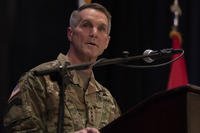The purpose of the Air Naval Gunfire Liaison Company officially is to "provide Marine Air Ground Task Force commanders a liaison capability with foreign area expertise to plan, coordinate, employ and conduct terminal control of fires in support of joint, allied and coalition forces." That means that they provide direct support to various joint, allied, coalition and Special Operations forces working within Marine Corps battlespace and conduct the coordination required in order for their commanders to access Marine Corps close air support, artillery, rockets and naval gunfire.
Their motto is "lightning from the sky, thunder from the sea," and when a four- to five-man ANGLICO squad calls in a strike, its meaning becomes self-evident. ANGLICO squads are trained to direct close air support, cannon artillery, rocket artillery, precision guided munitions, naval gunfire support and fire support coordination. Their objective is not to support Marine combat actions directly, but to support the broad scope of military actions in a given area.
Organization
Because ANGLICO units are not designed to work directly with other Marine forces, they are organized to work with different branches of the military as well as foreign militaries. The top tier is referred to as a division cell, and it is at this level that a combat arms lieutenant colonel coordinates between MAGTF and division headquarters. The second layer down is the brigade platoon and is led by a major artillery officer and a gunnery sergeant. Brigade platoons usually train and deploy together, and so they develop distinct identities.
The third layer is called a supporting arms liaison team, which is effectively similar to a battalion. These contain roughly 10 Marines and sailors, are led by a naval aviator and provide a comprehensive fire support coordination capability for a supported battalion. The lowest level of organization is the firepower control team. There are theoretically two per battalion, but that number shifts as needed. These FCTs operate alongside the units they're supporting and request air and fire support as needed.
Training
Marines undergo a broad spectrum of training to become a combat-ready ANGLICO. They must learn how to coordinate fire support, conduct field radio operations, direct air support and receive training in airborne operations, insertion methods, fieldcraft and other skills. Due to their operational purview, they also must train jointly with other U.S. units as well as allied forces.
History
ANGLICO units can trace their origin back to World War II in the Pacific theater. Originally called Joint Assault Signals Company, they were used to coordinate air, artillery and naval fire between the Marines, Army and Navy. These units were disbanded and their purview incorporated by the Navy, but in 1949, they were reformed into the ANGLICO units. They conducted operations in Vietnam, Korea, various small conflicts and were used to test the Joint Fires Observers concept. In 1999, the active units were disbanded, but the demands placed on the reserve units by the Global War on Terrorism predicated the need for reactivation and the creation of the 5th ANGLICO.
Want to Know More About the Military?
Be sure to get the latest news about the U.S. military, as well as critical info about how to join and all the benefits of service. Subscribe to Military.com and receive customized updates delivered straight to your inbox.











